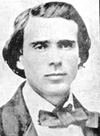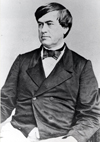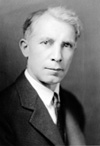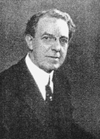"William Gregg, Factory Master of the old South".

 John was a confererate officer who led forces under Lee. He was born in Lawrence County, Alabama to Nathan Gregg and Sarah Pearsall Camp. He became a mathematics professor and studied law in Tuscumbia, Alabama. In 1852,he moved to Fairfield, Texas, where he was elected a District Judge. He became a member of the Provincial Congress of the Southern Confederacy and later resigned to form the 7th Texas Infantry. In 1858, John married Mary Francis Garth daughter of General Jessie Garth, a wealthy Alabama senator and Union supporter. Shorty after enlistment Gregg was captured and taken to Fort Warren, Massachusetts, for imprisonment where he was later traded for a Yankee prisoner. In September of 1862, he was commissioned brigadier general and sent to Mississippi. In the Battle of Raymond, on May 16th, 1863 his Army of 2,500 met a Union Army of 10,000. He was wounded at the Battle of Chickamauga on Sept 19, 1863, and sent to Marietta, Georgia to recover. One year later, October 7, 1864, General Gregg was killed during the Battle of Richmond.


 Governor of Pennsylvania. He was born in Bellefonte, Pennsylvania on April 22, 1815, the son of Roland Curtin who came from Ireland in 1793, and grandson of Andrew Gregg, Representative and Senator in Congress for Pa. He was elected Governor in October 1860. In 1869 President Grant appointed him U.S. minister to Russia. He served as a representative in the 47th, 48th and 49th congresses.1881-1887. He died at Bellefonte Pa. Oct. 7, 1894.
 John was an abolitionist who founded an anti-slavery school which later became Berea college. He was born in Bracken County, Kentucky Sept. 9, 1816 son of John Fee and Sarah Gregg. He attended Lane theological seminary and was ordained by the synod of Kentucky at Versailles, in 1844. He was president of the trustees of Berea College 1855-1892. He died in Berea Kentucky, January 11, 1901. Here is his autobiography published by the National Christian Association of Chicago Ill, 1891, in Documenting the Old South.
John was a Scotsman who fought in the battle of the Alamo. John McGregor, a native of Scotland, had a home in Nacodoches, Texas before deciding to travel to San Antonio to the fight in the Seige of Bexar. It was said that he and his bagpipes would duel with Davy Crockett and his fiddle during lulls in the battle at the Alamo.
 An American Philosopher, a modern pacifist and friend of Gandhi, the first American to develop a substantial theory of nonviolent resistance, coined the term "voluntary simplicity". Richard Gregg was a Harvard trained lawyer who practiced law for three years before working with trade unions where he assisted with arbitration for railroad workers following World War I. Richard was a convert to Quakerism from a Congregational minister’s family. He was inspired by an article on the work of Mohandas Gandhi and lived in Gandhi's Sbarmati ashram for several months in the mid-1920s on a journey through India, where he wrote "The Economicss of Khaddar". He returned to India as an observer during the 1930 Salt March. His publications include 'Gandhiji's Satyagraha or non-violent resistance 1930", "The Power Of Non Violence 1934", and his revision," The Power of Non-Violence 1960" which included a foreward by Martin Luther King. Some of his other notable publications include " The Compass of Civilization", "The Value of Voluntary Simplicity 1936", and "Training for Peace: A program for Peace Workers 1937". In 1935-36 he served as the acting director for Pendle Hill, moving form there to live in Putney,Vermont. Gregg worked closely with Gandhi in India. Gandhi nicknamed him Govind in letters which Gregg donated to the Swarthmore College Peace Collection. The influence of FOR (Fellowship of Reconciliation) was a channel for Gandhi's principals of nonviolence in theUSA, particularly for the civil rights movement under Martin Luther King. From the 1920s some members of FOR had direct contact with Gandhi, including Richard Gregg and Krishmalal Shridharmani an Indian graduate student. Martin Luther King called "The Power of Nonviolence 1934" one of the five most influential books he had ever read.
Grandmother of Harry S. Truman Harriet was born Oct. 15, 1818 in Shelby County, Kentucky. On January 3, 1838 she married Soloman Young, a successful farmer who owned and operated wagon trains heading west. Soloman was also born in Shelby County Kentucky three years earlier on April 24, 1815. Their daughter Martha Ellen Young born November 25, 1852 was a music major who married John Anderson Truman on December 28, 1881. John was a farmer, a livestock dealer, and a road overseer. He was the son of Andrew Shipp Truman and Mary Jane Holman. Harry S. Truman was born May 8, 1884 in Lamar, Missouri. He became the 33rd President of the United States.
Go to Life of William Clarke Quantrill. Quantrill gave Captain Gregg a rear guard of sixty men during the Lawrence attack. The attack was supposed retaliation for a Union raid on Osceola Missouri. Will and Frank Gregg, both sons of Jacob Gregg, rode for Quantrill. For a time Jesse James and his brother Frank, and Cole and Jim Younger were part of the band. Will and Franks father Jacob was the brother of Harmon, the father of Josiah Gregg(above). Here is a biological sketch of William from the State Historical Society of Missouri. William H. Gregg was born February 8, 1838, to Jacob and Nancy Lewis Gregg in Jackson County, Missouri. He married Elizabeth Eleanor Hook of Odessa on November 1864. They had five children. Gregg served under William Clarke Quantrill from December 1861 through the winter of 1863/1864. He left Quantrill's band near Sherman, Texas, at which time he joined General Joe Shelby and was made a captain in Shanks' Brigade. After the war he returned to his farm in Jackson County, and served as deputy sheriff during which time he wrote of his experiences with Quantrill. Captain Gregg died April 22, 1916. William H. Gregg's "A Little Dab of History Without Embellishment," written in 1906, is a memoir of his service under Confederate guerrilla William Clarke Quantrill from December 1861 to 1864, and includes a description of the sack of Lawrence, Kansas.
  Back to the Gregg Page Back to the Gregg Page
|
 "
"